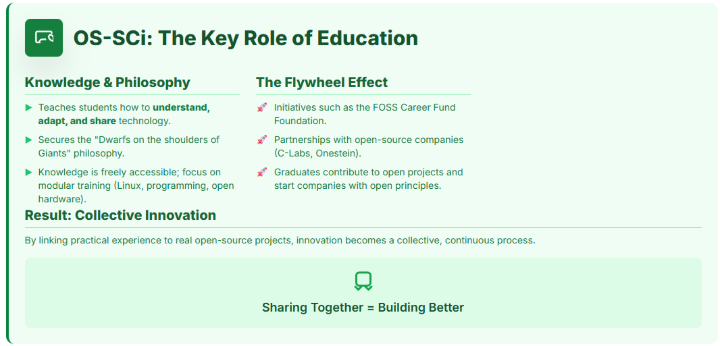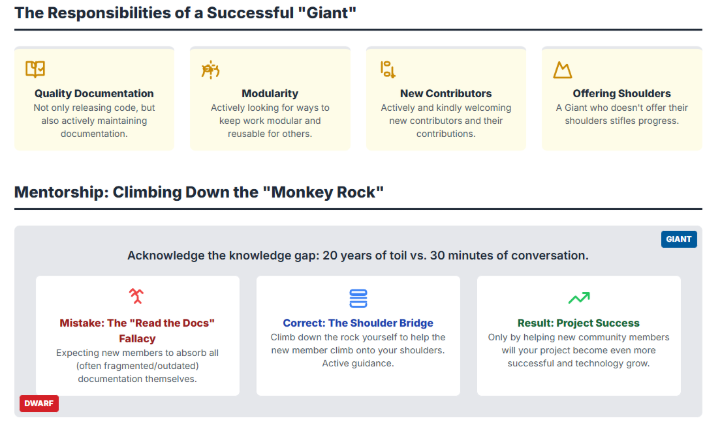In my youth, Lego was more than just a toy, it was a gateway to endless imagination and an early lesson in collaboration and reuse. Every birthday or holiday, my brother and I would eagerly unwrap new Lego sets, following the instruction manuals to build models step by step: from race cars and spaceships to medieval castles. But the real adventure began once the last brick was in place, and we fearlessly dismantled our creations. We combined our loose bricks, letting our creativity run wild. Our bedroom floor transformed into a construction site where we no longer played by the rules but by our own vision. We built futuristic cities, underground tunnels, and secret bases, each brick a new building block for our imagination.


What we didn’t realize at the time was that we were unconsciously living by the principle of standing on the shoulders of giants. Just as we built upon the foundation Lego designers provided, free software and open source work the same way: developers build on each other’s code, share knowledge, and innovate without constraints. Imagine if Lego were proprietary, if each set could only be built one way, if you couldn’t mix bricks with others, or if you needed a new box for every new idea. The magic would vanish, just as it does in the proprietary software world, where closed systems stifle creativity. Open source is like an endless bin of Lego: everyone can contribute, reuse, and share, allowing the next generation to build even higher. Knowledge grows organically and without boundaries, just like our Lego worlds.

To add some nuance: Lego is, of course, a company that fiercely protects its intellectual property.Innovation and collaboration are only permitted within the Lego universe, But the analogy sounds so good. Next there are no Lego patents anymore and lots of companies started with their own compatable bricks.

Now, imagine a world where software and hardware are as modular and accessible as a giant tub of Lego. In this world, operating systems, apps, and even computer chips aren’t locked away as the property of a single corporation but are open building blocks anyone can understand, modify, and combine. Just as children don’t need permission to turn a Lego castle into a spaceship, developers, makers, and users could freely experiment with technology. Bugs would be fixed faster because thousands of eyes are reviewing and improving the code. Innovation would accelerate because you wouldn’t have to start from scratch every time, you could build on what already works. Hardware would last longer because you could replace and upgrade components instead of discarding entire
devices. Schools would teach children not just how to use technology but how it works and how they can shape it themselves.

The societal benefits? A digital world that is more transparent, secure, and inclusive. No
dependence on a handful of tech giants, but an ecosystem where knowledge is shared and everyone, whether a student, small business owner, or scientist, can participate. Just as Lego taught us that building together is more fun and smarter than going it alone, open technology would show us that collaboration leads to better, fairer, and more sustainable solutions. It wouldn’t just bridge the digital divide; it would foster a culture of creativity and ownership. When technology truly belongs to everyone, we can create something more beautiful together.
A Blueprint for a Lego-Like Tech World, and How OS-SCi Plays a Key Role

Transitioning to an open, modular technological ecosystem requires concrete steps. First, we need to raise awareness: governments, educational institutions, and businesses must recognize that open standards and reusable building blocks aren’t just ethical but also economically and ecologically advantageous. Next, education is crucial, from primary schools to universities, where students learn to be not just consumers of technology but makers. Additionally, we must actively support open-source projects, for example, through grants, tax incentives for companies contributing to open ecosystems, and legislation that combats vendor lock-in. Finally, collaboration among businesses,
governments, and citizens is essential to standardize open hardware and software so that components work seamlessly together, just like Lego bricks.

This is where OS-SCi comes in. As an open-source educational institution, OS-SCi teaches students not only how to use technology but, more importantly, how to understand, adapt, and share it. Through modular courses, from Linux and programming to open hardware, OS-SCi embodies the "standing on the shoulders of giants" philosophy: each new generation builds on what came before, without reinventing the wheel or creating dependencies. With initiatives like the FOSS Career Fund Foundation and partnerships with open-source companies such as C-Labs and Onestein, OS-SCi creates a flywheel effect: graduates contribute to open projects, launch businesses with open principles, and accelerate the transition. By making knowledge freely accessible and linking practical experience to real open-source projects, innovation becomes a collective process. This
way, not only does technology grow, but so does a society that understands: the most beautiful structures are built when we share the blocks.
A Side Note for Developers

The idea of standing on the shoulders of giants is the philosophical core of open source, yet in practice, many developers forget that they, too, once climbed onto others’ shoulders. Some FOSS developers see other open-source projects as competitors, as if there’s only limited room for success, when in fact, collaboration and reuse are the strengths of open source. This mindset stifles innovation: if every project reinvents the wheel, the community fragments its energy and misses the chance to create truly transformative solutions. It’s like locking Lego bricks in separate boxes: you limit not only yourself but also others who could have built on your work. When your project grows
and becomes a giant, responsibility comes with it: actively contributing to the community that made you possible. That means not just releasing code but improving documentation, welcoming new contributors, and consciously making your work modular and reusable. A giant that doesn’t offer its shoulders halts progress; one that does strengthens the entire community. Open source isn’t about competition, it’s about collective growth, because every brick you add makes the tower everyone can climb just a little taller.

When new developers join your project, as a giant, you must sometimes climb down from your perch and remember how you got there. Years of hard work, struggle, and persistence gave you a knowledge advantage over these newcomers. Help them climb onto your shoulders. Don’t expect them to absorb two decades of expertise in a 30-minute conversation or even two weeks. You can’t just tell them to "read the documentation," because let’s be honest, you know it’s often outdated and scattered. After all, we are dwarfs standing on the shoulders of giants. Much of the knowledge
exists in different places. Help these new community members move forward, because only then can we make our projects even more successful.